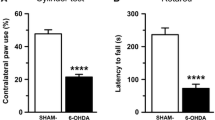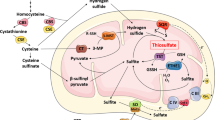Abstract
The major symptoms of Parkinson's disease (PD) are tremors, hypokinesia, rigidity, and abnormal posture, caused by degeneration of dopamine (DA) neurons in the substantia nigra (SN) and deficiency of DA in the neostriatal dopaminergic terminals. Norepinephrine, serotonin, and melanin pigments are also decreased and cholinergic activity is increased. The cause of PD is unknown. Increased methylation reactions may play a role in the etiology of PD, because it has been observed recently that the CNS administration of S-adenosyl-l-methionine (SAM), the methyl donor, caused tremors, hypokinesia, and rigidity; symptoms that resemble those that occur in PD. Furthermore, many of the biochemical changes seen in PD resemble changes that could occur if SAM-dependent methylation reactions are increased in the brain, and interestingly,l-DOPA, the most effective drug used to treat PD, reacts avidly with SAM. So methylation may be important in PD; an idea that is of particular interest because methylation reactions increase in aging, the symptoms of PD are strikingly similar to the neurological and functional changes seen in advanced aging, and PD is age-related. For methylation to be regarded as important in PD it means that, along with its biochemical reactions and behavioral effects, increased methylation should also cause specific neuronal degeneration. To know this, the effects of an increase in methylation in the brain were studied by injecting SAM into the lateral ventricle of rats. The injection of SAM caused neuronal degeneration, noted by a loss of neurons, gliosis, and increased silver reactive fibers in the SN. The degeneration was accompanied with a decrease in SN tyrosine hydroxylase (TH) immunoreactivity, and degeneration of TH-containing fibers. At the injection site in the lateral ventricle it appears that SAM caused a weakening or dissolution of the intercellular substances; observed as a disruption of the ependymal cell layer and the adjacent caudate tissues. SAM may also cause brain atrophy; evidenced by the dilation of the cerebral ventricle. Most of the SAM-induced anatomical changes that were observed in the rat model are similar to the changes that occur in PD, which further support a role of SAM-dependent increased methylation in PD.
Similar content being viewed by others
References
Tretiakoff C. (1919) Thesis, Paris. (Cited in Schultz ref. 41 Gharib A., Sarda N., Chabannes B., Cronenberger L., and Pacheco H. (1982)J. Neurochem. 38(3), 810).
Foix C. and Nicolesco J. (1925) Masson Paris. (Cited in Jellinger K. [1986] Overview of morphological changes in Parkinson's disease.Adv. Neurol. 45, 1–18).
Greenfield J. G. and Bosanquest F. D. (1953)J. Neurol. Neurosurg. Psychiat. 16, 213.
Hornykiewicz O. (1966)Pharmacol. Rev. 18, 925.
Poirier L. J. and Sourkes T. L. (1965)Brain 88, 181.
Nagatsu T. (1990)Adv. Neurol. 53, 207.
Yahr M. D. and Bering E. A. (1968) inParkinson's Disease: Present Status and Research Trends, Columbia University Press, New York, p. 47.
Bernheimer H. and Hornykiewicz O. (1965)Klin-ther. Wschr. 42, 711. (Cited in Schultz, ref. 41 Gharib A., Sarda N., Chabannes B., Cronenberger L., and Pacheco H. (1982)J. Neurochem. 38(3), 810).
Barbeau A. (1968)Proc. Aust. Asso. Neurol. 5, 95.
Sharman D. F. (1976) inThird Symposium on Parkinson's Disease (Gillingham F. J. and Donaldson I. M. L., eds.), E. and L. Livingston, London, p 24.
Bernheimer H., Birkmayer W., and Hornykiewicz O. (1961)Klin-ther. Wschr. 39, 1056. (cited in Schultz, ref. 41 Gharib A., Sarda N., Chabannes B., Cronenberger L., and Pacheco H. (1982)J. Neurochem. 38(3), 810).
Ehringer H. and Hornykiewicz O. (1960)Klin-ther. Wschr. 38, 1236. (Cited in Schultz, ref. 41 Gharib A., Sarda N., Chabannes B., Cronenberger L., and Pacheco H. (1982)J. Neurochem. 38(3), 810).
Paulus W. and Jellinger K. (1991)J. Neuropath. Exprl. Neurol. 50, 743.
Hoehn M. N., Crowlry T. J., and Rutledge C. O. (1976)J. Neurol. Neurosurg. Psychiat. 39, 941.
Jovoy-Agid F. and Agrid Y. (1980)Neurology 30, 1326.
Turkka J. T. and Myllyla V. V. (1987)Eur. J. Neurol. 26, 1.
Ludin S. M., Steiger U. H., and Ludin H. P. (1987)J. Neurol. 235, 10.
Shelby G. (1968)J. Neurol Sci. 6, 517.
Alvord E. C. Jr., Forno L. S., Russke J. A., Kaufman R. J., Rhodes J. S., and Goetowski C. R. (1974)Adv. Neurol. 5, 175.
Jager D. H. and Bethlem J. (1960)J. Neurol. Neurosurg. Psychiat. 6, 283.
Ohama E. and Ikuta F. (1976)Acta. Neuropathol. (Berl.) 34, 311.
Langston J. W. and Forno L. S. (1978)Ann. Neurol. 3, 129.
Eadie M. J. (1963)Brain 86, 781.
Vanderhaegen J. J., Poirier O., Steronon J. E. (1970)Arch. Neurol. 22, 207.
Rajput A. H. and Rozdilsky B. (1970)J. Neurol. Neurosurg. Psychiat. 39, 1092.
Forno L. S. and Norvill R. L. (1976)Acta Neuropathol. 34, 183.
Jellinger R. (1986)Adv. Nerurol. 45, 1.
Jager W. A. den (1969)Arch. Neurol. (Chicago) 21, 615.
Ward C. D., Duvosin R. C., Ince S. E., Nutt J. D., Elridge R., and Calne D. B. (1983)Neurology 33, 815.
Knoll J. (1988)Mech. Aging and Dev. 46, 237.
McGree P. L., McGree E. G., and Suzeki J. S. (1977)Arch. Neurol. 34, 33.
Charlton C. G. and Way E. L. (1978)J. Pharm. Pharmac. 30, 819.
Charlton C. G. (1990) inBasic Clinical and Therapeutic Aspects of Alzheimer's and Parkinson's Diseases, vol. 1 (Nagatsu T. et al., eds.), Plenum, New York, pp. 333–339.
Charlton C. G. and Crowell B. Jr. (1992)J. Pharm. Biochem. Beh. 43, 423.
Crowell B. G. Jr., Benson R., Shockley D., and Charlton C. G. (1993)Beh. Neural. Bio. 59, 186.
Ernst A. M. (1962)Nature (Lond.),193, 178.
Collins M. A., Neafsey E. J., Matsubara K., Cobuzzi R. J.Jr., and Rollema H. (1992)Brain Res. 570, 154.
Mays L. L. and Borek E. (1973)Nature 243, 411.
Stramentinoli G., Gualano M., Catto E., and Algeri S. J. (1977).J. Gerontol. 32(4), 392.
Tuomisto L. (1977)J. Neurochem. 28, 271.
Gharib A., Sarda N., Chabannes B., Cronenberger L., and Pacheco H. (1982)J. Neurochem. 38(3), 810.
Sellinger O. Z., Kramer C. M., Conger A., and Duboff G. S. (1988) inMechanism of Aging and Development 43, 161.
Volpe J. J. and Laster L. J. (1970)J. Neurochem. 17, 413.
Baldessarini R. J. and Ropin I. J. (1966).J. Neurochem. 13, 769.
Blusztajn J. R., Ziesel S. H., and Wurtman R. J. (1979)Brain Res. 179, 319.
Hirata F. and Axelrod J. (1978)Nature 275(5677), 219.
Muenter M. D., Sharpless N. S., and Tyce G. M. (1972)Mayo Clin. Proc. 47, 389.
Feuerstein C., Tauche M., Serre F., Gavend M., Pellat J., and Perret J. (1977)Acta. Neurol. Scand. 56, 79.
Mena M. A., Murados V., Brazen E., Reiriz J., and De Yebenes J. G. (1977)Adv. Neurol. 45, 481.
Hardie R. J., Lees A. J., and Stern G. M. (1986)Adv. Neurol. 45, 487.
Wurtman R. J., Rose C. M., and Matthyssee S. (1970)Science 169, 395.
Mays-Hoopes L. (1985) inMolecular Biology of Aging: Gene Stability and Gene Expression (Sohal R. S., et al. eds.), Raven, New York, p. 49.
Albert B., Bray D., Lewis J., Raff M., Roberts R., and Watson J. D. (1989)Molecular Biology of the Cell, 2nd ed. Garland, New York.
Jenner P. J. and Marsden C. D. (1988) inParkinson's Disease and Movement Disorders (Jankovic J. and Tolosa E., eds.), Urban and Schwarzenberg, Baltimore—Munich, pp. 37–48.
Schultz W. (1988)Gen. Pharmac. 19(2), 153.
Coons A. H. (1958) inGeneral Cytochemical Methods (Danielli J. F., ed.), Academic, New York, pp. 339–422.
Clark G. (1989)Staining Procedures, 4th ed., Williams and Wilkins, Baltimore, MD.
Fink R. P. and Heimer L. (1967)Brain Res. 4, 369.
Crowell B. Jr. and Charlton C. G. (1992)Neurosci. Abst. 658, 15.
Gagnon C., Axelrod J., and Brownstein M. J. (1978).Life Sci. 22, 2155.
Diliberto E. J., Viveros O. H., and Axelrod J. (1976)Proc. Natl. Acad. Sci. USA 73, 4050.
Randal E. I. (1990)Adv. Neurol. 53, 305.
Maybery H. S., Starkstein S. E., Sadzot B., Preziosi T., Andrezejewski P. L., Dannals R. F., Wagner H. N. Jr., and Robinson R. G. (1990)Ann. Neurol. 28, 57.
Goldman J. and Cote L. (1991) inPrinciple of Neural. J. Science, 3rd ed. (Kendel E. R., Schwartz J. H., and Jessell T. M., eds.), Appleton and Lange, Norwalk, CT, pp. 974–983.
Author information
Authors and Affiliations
Rights and permissions
About this article
Cite this article
Charlton, C.G., Mack, J. Substantia nigra degeneration and tyrosine hydroxylase depletion caused by excess S-adenosylmethionine in the rat brain. Mol Neurobiol 9, 149–161 (1994). https://doi.org/10.1007/BF02816115
Issue Date:
DOI: https://doi.org/10.1007/BF02816115




